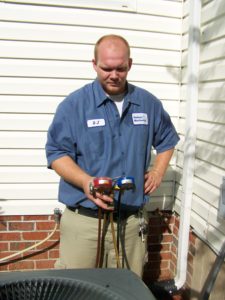AIR CONDITIONING REFRIGERANT LEAKS
 As the summer heat progresses, homeowners discover their air conditioners are working longer and harder, which can lead to failures. The harder and longer their equipment runs, the more likely it will demand attention to be maintained. A common cause of failure is refrigerant leakage. Temperatures higher in your home incapable of satisfying the thermostat setting is a probable symptom related to refrigerant leaking. Properly trained and certified technicians can diagnose this issue quickly and simply add more refrigerant based on the measurement their gauges determine. This may just be a temporary fix, so it is advised to perform a leak test using bubble soap solutions or an electronic leak detector to pinpoint the leak location. Leak tests can be time consuming dependent on the leak location and size. We recommended performing the repair in addition to recharging the system with the proper level of refrigerant per the manufacturer’s specifications. It is important that the technician is EPA certified to ensure refrigerant is properly handled and complying with regulations. There are several causes for refrigerant leaking:
As the summer heat progresses, homeowners discover their air conditioners are working longer and harder, which can lead to failures. The harder and longer their equipment runs, the more likely it will demand attention to be maintained. A common cause of failure is refrigerant leakage. Temperatures higher in your home incapable of satisfying the thermostat setting is a probable symptom related to refrigerant leaking. Properly trained and certified technicians can diagnose this issue quickly and simply add more refrigerant based on the measurement their gauges determine. This may just be a temporary fix, so it is advised to perform a leak test using bubble soap solutions or an electronic leak detector to pinpoint the leak location. Leak tests can be time consuming dependent on the leak location and size. We recommended performing the repair in addition to recharging the system with the proper level of refrigerant per the manufacturer’s specifications. It is important that the technician is EPA certified to ensure refrigerant is properly handled and complying with regulations. There are several causes for refrigerant leaking:
- Mother Nature: Coastal environments can contribute to advanced coil damage with sand and salt water corrosion. Storms are not friendly with air conditions or heat pumps delivering debris in the outdoor units, causing airflow restrictions and corrosion. Living on or the near coastal regions can expedite equipment aging and shorten the equipment life. Virginia Beach resort area, Croatan and Sandbridge specifically have seen equipment last only 5-7 years when not regularly maintained or coil coated. Air conditioners and heat pumps inland should experience a life span of 10-12 years. Copper coils are also subject to microscopic cracks from nature’s affects of formicary corrosion.
- Installation: Brazing joints incorrectly can create pinhole leaks that could likely cause slow leaks, taking several years to notice the uncomfortable affects.
- Manufacturer Processing: improper welding, packing or shipping may create holes as well.
- Inadvertent Damage: Nails through the line set in the wall when hanging wall décor, outdoor project mishaps: weed eating too close to equipment damaging lines, standing on equipment attempting to work on exterior improvements or materials/tools falling in unit causes damage, outdoor kids activities, power washing or animals/pets digging or clawing at equipment. Even an animal’s urine can corrode the components.
- Huffing: It has been reported from enforcement agents that teens have been caught huffing refrigerant to get high. This is dangerous and can cause brain damage, lung damage or even death. Refrigerant locking caps are a great solution to prevent refrigerant theft and save lives.
The cost of refrigerant has fluctuated tremendously over the past several years for R-22. We have seen R-22 rise to approximately $190 per pound for the consumer in the past 4 years. R-22 operated equipment is no longer manufactured, so there is a limited supply controlled by the EPA, so costs have risen. More efficient equipment has been designed in recent years requiring R-410 which is a more environmentally friendly product and in ample supply.
Best solutions to prevent discomfort and inconvenience due to air conditioning failures:
- Invest in an annual maintenance agreements with a qualified HVAC contractor. Research shows that annual maintenance reduces failure rates and saves you up to 30% on heating and cooling energy bills annually.
2. Change your filters monthly. Dirty filters can restrict airflow and cause system failure.
